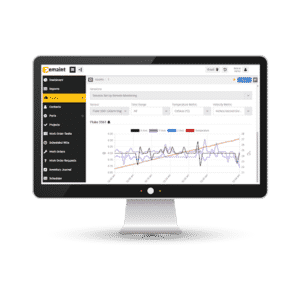Organizations that adopt predictive maintenance strategies by adding wireless asset condition monitoring tools gain a significant advantage over competitors.
According to a study by the Deloitte Analytics Institute, predictive maintenance solutions can reduce maintenance planning by 20-50 percent, increase asset availability by up to 20 percent, and decrease maintenance costs by 5-10 percent.
eMaint CMMS users can advance their journey toward predictive maintenance by integrating Fluke condition monitoring tools such as the Fluke 3561 FC Vibration Sensors and the 3540 FC Three-Phase Power Monitor.
This integration can be seamless using Fluke Connect software. It will enable you to view data wirelessly from the field, plant, or home via a desktop, laptop, or mobile phone.

A summary of the benefits of connecting Fluke sensors to eMaint:
- Continuously monitor asset health
- Receive alerts if equipment conditions change
- Trend data, catch anomalies, and predict future machinery issues
- Make timely repair and replace decisions early
- Avoid potential asset failure
Test your condition monitoring readiness
If you’re considering integrating Fluke condition monitoring tools with your eMaint CMMS, you should first evaluate your current maintenance program. Is your CMMS optimized? If not, make that a prime task. You can then proceed with determining whether you’re ready to add condition monitoring.
Below you’ll find a summary of the complete guide. Download the 5 Tips for Integrating Fluke Sensors into eMaint here.
Five integration tips
1. If you haven’t already — implement a CMMS
To be sure, the foundation for a connected reliability journey begins with a CMMS. The system enables you to build a central asset maintenance and management database, which can be accessed remotely.
2. Check your connection
Fluke Connect sensors and power monitoring tools transmit data to the cloud using Wi-Fi. If you don’t have reliable internet or your organization experiences connectivity issues, explore workarounds.
3. Test drive the sensors
Whether you plan to go big or not with your sensor implementation, a pilot program can help determine if now’s the time. By testing sensors first, you’ll be able to flesh out your remote condition monitoring readiness and connectivity capacity. One company actually avoided an asset failure during its trial. See the complete guide for the details.
4. Leverage the data
Data is only valuable if it’s accurate and fully utilized. Who will be responsible for ensuring that the sensor data is actionable? How will you confirm if the sensors improved overall maintenance and operations? Tracking key performance indicators (KPIs) provide a way to measure continuous improvement.
5. Consider the asset’s value
If you’re not sure which assets to monitor or why, defining the criteria and asset criticality can help. Also, make sure you’re matching the right sensor to the right equipment.
Fluke Connect software collects, stores and makes viewable machine data from more than 80 Fluke tools and sensors.
Read the complete article, “5 Tips for Integrating Fluke Sensors into eMaint.”
